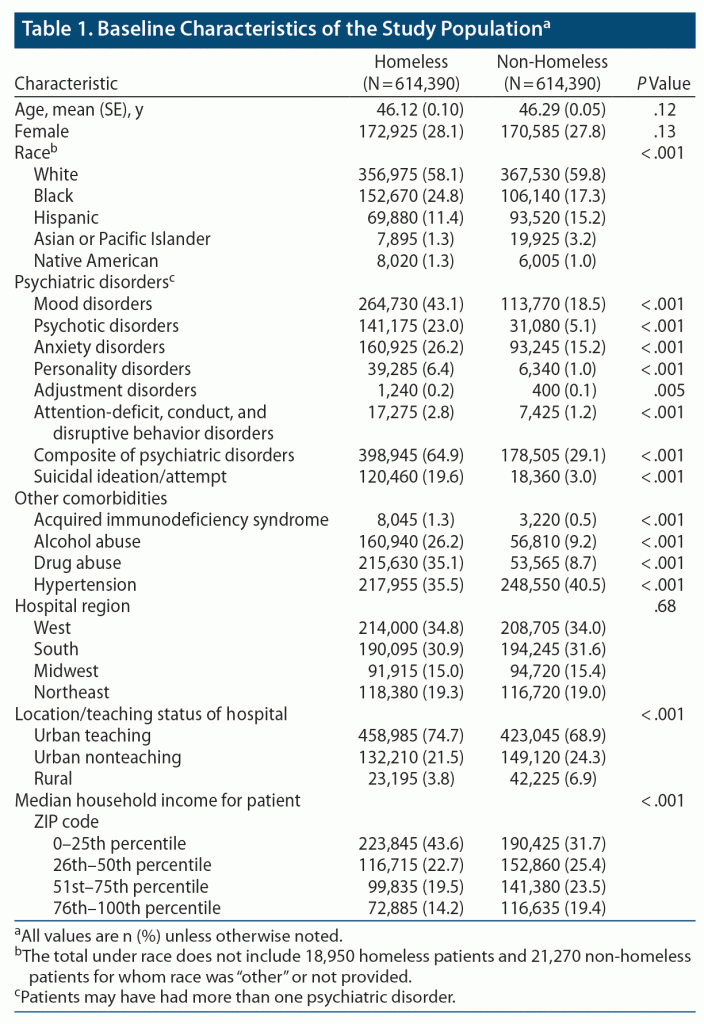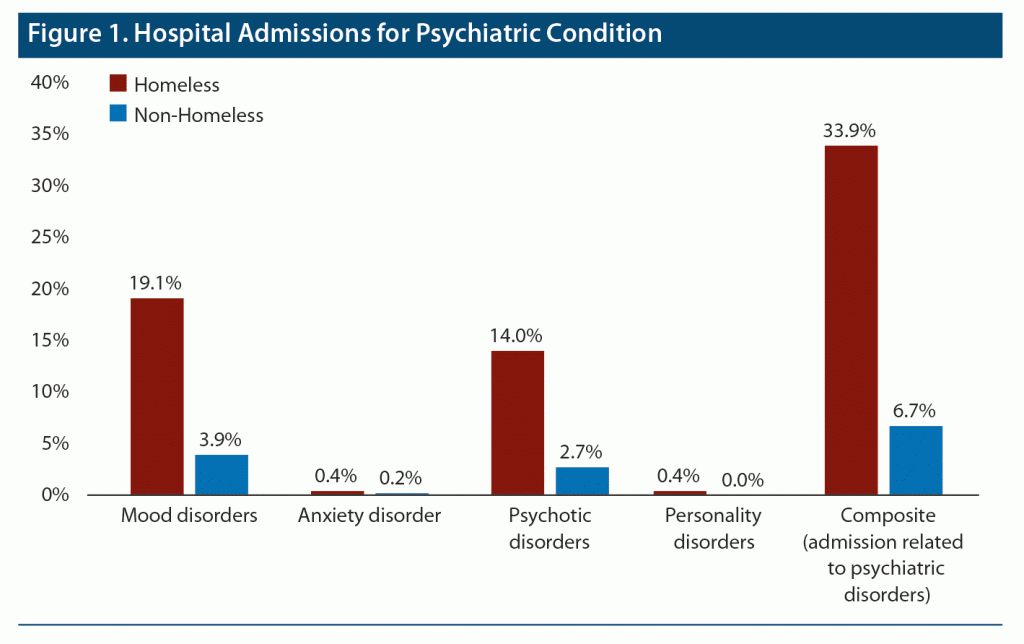ABSTRACT
Objective: To compare the incidence of inpatient psychiatric admissions and evaluate the prevalence of psychiatric disorders among homeless individuals.
Methods: This cross-sectional study utilized the Nationwide Inpatient Sample dataset for the year 2016–2017. US adult homeless patients (age ≥ 18 years) admitted to the hospital were age and sex matched (1:1) with non-homeless individuals using the propensity score matching technique.
Results: The study included a total of 614,390 homeless patients (mean age = 46.1 years, 71.9% male). Most of the homeless patients were Black (24.8% vs 17.3% of the non-homeless population). Mood, anxiety, and psychotic disorders were highly prevalent in homeless patients compared to those who were non-homeless (P < .001). Composite of psychiatric disorders was also significantly higher in the homeless group (64.9% vs 29.1%, P < .001). Suicidal ideation was present in 19.4% of the homeless individuals and in 2.9% of the non-homeless (P < .001). Hospital admissions related to any psychiatric condition were 33.9% in the homeless and 6.7% in the non-homeless (P < .001). Compared to the non-homeless, homeless patients admitted for psychiatric disorders had longer inpatient psychiatric admissions (8.7 vs 7.7 days, P < .001).
Conclusions: The results revealed a positive association between homelessness, comorbid psychiatric disorders, and suicidal ideations/attempts. Appropriate psychiatric screening measures are needed for the homeless. Homelessness is associated with longer inpatient psychiatric stay. The challenges faced in treating and preventing mental illness in the homeless should be investigated further.
Prim Care Companion CNS Disord 2022;24(6):21m03209
To cite: Trivedi C, Adnan M, Shah K, et al. Psychiatric disorders in hospitalized homeless individuals: a nationwide study. Prim Care Companion CNS Disord. 2022;24(6):21m03209.
To share: https://doi.org/10.4088/PCC.21m03209
© 2022 Physicians Postgraduate Press, Inc.
aDepartment of Psychiatry, Texas Tech University Health Science Center at Odessa/Permian Basin Odessa, Odessa, Texas
bGriffin Memorial Hospital, Norman, Oklahoma
cDepartment of Psychiatry, Boston Children’s Hospital/ Harvard Medical School, Boston, Massachusetts
*Corresponding author: Chintan Trivedi, MD, MPH, Texas Tech University Health Science Center, 3600N Garfield St, Mildand, TX 79705 ([email protected]).
Homelessness is a significant public health concern. A person is considered homeless if they do not have a regular and permanent nighttime residence, their main nighttime residence is a privately or publicly owned setting not intended for or normally used as regular living accommodation for humans (eg, car, park, abandoned building, bus or train station), or they have temporary living arrangements such as in supervised shelters.1 A conglomeration of factors contribute to homelessness, including personal circumstances, social factors, personal vulnerability, societal insufficiencies, and mental health issues.2
US Department of Housing and Urban Development (HUD) statistics indicate that on a single night in 2019, around 567,715 persons experienced homelessness.3 Homeless individuals have disproportionately higher rates of illnesses and die, on average, 12 years prematurely compared to the general population.4 A lack of personal safety measures like loss of employment, no preventive health services, poverty, and savings exhaustion cause poor health. In a survey of 564,708 homeless individuals, about 18.5% (104,083) were classified as having severe mental illness and a higher suicide rate than the general population.3,5 More than 50% of the homeless reported suicidal thoughts or attempted suicide in another study.6
The connection between homelessness and mental illness is a complicated, 2-way relationship. An individual’s mental illness may hinder their ability to maintain stable housing. Mental illness may lead to behavioral problems and cognitive decline, making it challenging to earn a stable income or sustain a steady lifestyle. Even a single, short episode of homelessness in the mentally ill has been shown to cause significant psychiatric distress and impede recovery and remission.7
Severe, untreated mental illness leads to high mortality rates and suicide and increases the odds of being a target of violence or involved in a crime.8 Comorbid medical illness, physical trauma, substance use, existential despair, and a tumultuous social environment complicate assessment and hinder care.
Nearly 80% of the homeless have a high decline in cognitive functioning attributed to severe mental illnesses, among other causes.9 The expected payer for almost half of hospitalized homeless patients and more than 30% of homeless patients in the emergency department has been shown to be the Medicaid program, indicating high economic taxpayer burden.10 Thus, there is a pressing need to study the prevalence of psychiatric disorders and psychiatric inpatient treatment in the homeless population.
The objective of this study was to evaluate the prevalence of psychiatric disorders in homeless patients compared with non-homeless patients. Length of stay and economic burden caused by inpatient psychiatric treatment of homeless patients were also assessed.
METHODS
In this cross-sectional study, we utilized the National Inpatient Sample (NIS) dataset, which is part of a family of databases developed by the Healthcare Cost and Utilization Project, for the year 2016–2017.11 The dataset contains records from various US hospitals with more than 200 patient- and hospital-level variables. We used available discharge-level weights to obtain national estimates. Each record in the dataset contains information on age, sex, race, comorbidities, all type of primary-secondary diagnosis, total cost of hospitalization, length of stay, hospital location, primary insurance, admission month, admission day of the week, and discharge disposition. The diagnoses are provided using the International Classification of Diseases (ICD) diagnoses. The ICD-10 coding system was used for this study. We used the ICD-10 code Z59.0 for homelessness to select our primary homeless population aged ≥ 18 years. To compare these patients, we selected an age- and sex-matched control group. We performed dataset queries to obtain data on mood disorders, anxiety disorders, personality disorders, schizophrenia and other psychotic disorders, adjustment disorders, attention-deficit/hyperactivity disorder (ADHD) and other conduct disorders, and suicidality based on the Clinical Classifications Software of NIS dataset.12
Statistical Analysis
Number and percentage were used to describe categorical data and mean (standard error) to describe continuous data. Student t test and Rao-Scott adjusted χ2 test were performed for group comparisons. Bar diagrams were used to show inpatient psychiatric admissions. All tests were 2-sided, and a P < .05 was considered statistically significant. We excluded records with any missing data. Both groups were matched 1:1 for age and sex from random order using propensity score matching with a caliper size of 0.001. SPSS version 26.0 software for Windows (IBM Software Inc, Armonk, New York) was used to conduct the dataset stratification and clustering. Also, R Foundation for Statistical Computing version 3.6.3 was used to perform 1-to-1 matching.13
RESULTS
Table 1 shows participant baseline characteristics. We included 614,390 adult homeless patients in the study (mean age = 46.1 years, 71.9% male). Patients in the non-homeless group were initially mostly female (58.2%) (mean age = 57.97 years). To reduce the imbalance between the groups, we performed 1-to-1 age and sex matching. After matching, each group had 614,390 patients. Most of the homeless patients compared to the non-homeless were Black (24.8% vs 17.3%), and fewer homeless patients were Hispanic (11.4% vs 15.2%). There was no significant difference between the homeless and non-homeless groups for White race (58.1% vs 59.8%). There was no significant difference in the inpatient hospitalization rates among the 4 regions of the United States. The urban teaching hospitals had more homeless than non-homeless patients admitted (74.7% vs 68.9%). The rural hospitals had fewer homeless than non-homeless patients (3.8% vs 6.9%). Homeless patients had a significantly higher prevalence (P < .001) of acquired immunodeficiency syndrome (1.3% vs 0.5%), alcohol abuse (26.2% vs 9.2%), and drug abuse (35.1% vs 8.7%) than non-homeless patients.
Psychiatric Disorders
The homeless had a higher rate of psychiatric disorders compared to the non-homeless group. Mood disorders (43.1% vs 18.5%), anxiety disorders (26.2% vs 15.2%), and psychotic disorders were highly prevalent in homeless patients compared to the non-homeless. Bipolar depression was prevalent in 15.6% of homeless patients (4.6% in non-homeless, P < .001), and major depressive disorder was present in 26.3% of homeless patients (13.6% in non-homeless, P < .001).
Composite of psychiatric disorders (psychotic disorders, anxiety disorders, personality disorders, adjustment disorders, ADHD, and other conduct disorders) was significantly high (P < .001) in homeless patients (64.9%) compared to non-homeless patients (29.1%). Suicidal ideation was present in 19.4% of patients in the homeless group and 2.9% of those in the non-homeless group (P < .001). Suicide attempt was also high in homeless patients (0.3%) compared to the non-homeless group (0.1%) (P < .001).
Hospitalization for Psychiatric Disorders
We also assessed the hospitalization rate related to psychiatric conditions from the primary diagnosis data (Figure 1). Mood disorders caused 19.1% of homeless inpatient psychiatric admissions compared to 3.9% for non-homeless patients (P < .001). Due to psychotic disorders, hospital admission was 14.0% in the homeless patients compared to 2.7% in the non-homeless group. Hospital admission related to any psychiatric disorder was 33.9% in the homeless group compared to 6.7% in the non-homeless population (P < .001). In patients admitted for psychiatric disorders, the homeless patients’ length of stay was longer (8.7 vs 7.7 days, P < .001) after controlling for hospital type. The total hospitalization costs were significantly higher in the homeless population ($7,623 vs $6,985, P < .001) compared to the non-homeless group after controlling for area wage index and hospital type.
DISCUSSION
Almost two-thirds of the homeless patients had psychiatric disorders compared to only one-third of the patients in the age- and sex-matched non-homeless group. The homeless demonstrated more suicidal ideations and suicide attempts than did the non-homeless. Of all hospitalization, psychiatric hospitalization was expected, with one-third of the homeless patients admitted for psychiatry-related illness compared to 7% of patients in the non-homeless group.
Homelessness itself is a known predictor of inpatient psychiatric hospitalization.14 Lamparter et al15 compared emergency department visits between homeless and non-homeless patients. In that study,15 the inpatient psychiatric admission rate was similar to our findings (34% vs 4% in the homeless and non-homeless group, respectively). Psychiatric disorders were less prevalent than in our study (56% vs 10% in the homeless and non-homeless group, respectively); however, their sample size was small (n = 138).15 A large sample study16 conducted at homeless shelters in Denmark also found that almost 60% of patients had psychiatric disorders.
Similar to our findings, Noël et al17 showed the association between homelessness and suicidality. In that study,17 suicidal ideation was present in 30% of patients, which was higher compared to 20% in our study. Interestingly, in the same study,17 the homeless group showed approximately a 3-fold decrease in suicidal ideation over 24 months of follow-up after housing intervention. The authors17 suggest that placing these individuals in homes through a housing intervention project can reduce the suicide rate.
Like our findings, research has shown the higher costs associated with treating the homeless population. Hwang et al18 found a higher cost for homeless patients admitted to the hospital for psychiatric illness. The psychiatric service cost of homeless patient admissions was $1,058 more (P < .001) than housed patient admissions even after adjustment for length of stay, age, and sex. However, contrary to our findings, they18 did not observe a difference in the length of stay (16.9 vs 16.1 days, P = .37) between the homeless and housed population.
Mood disorders were the most prevalent psychiatric disorders among the homeless population in our study (43% in homeless vs 18.5% in non-homeless). A meta-analysis19 revealed that 21% of homeless patients have psychosis. An extensive review20 combining studies from several countries showed high regional variability in the rate of schizophrenia from 1% to 45%. Also, the rate of mood disorders ranged from 5%–43%, which implies that there could be an influence of public policy or a governing organization taking care of homeless individuals.20
This study is the first, to our knowledge, to compare a large sample of hospitalized homeless patients with an age- and sex-matched housed population. We also evaluated admissions related to psychiatric comorbidity in the patient population.
The considerable age- and sex-matched population sample size is a strength of our study. Limitations include unavailability of prospective and retrospective correlations due to the cross-sectional study design. Also, each record in the dataset is a patient visit, not the specific patient, so there is a chance that the same patient was counted more than once. Additionally, it was not possible to validate individual ICD codes in the dataset. Due to limited variables, the chance of biases and confounders is high. However, the implemented matching technique from random order reduced the confounding effect. Our inpatient hospitalization result may not be generalized to the general population.
CONCLUSIONS
In summary, this study’s findings reveal a positive association between homelessness and comorbid psychiatric illness. The study also provides information on the hospital burden associated with psychiatric disorders. Our findings emphasize the importance of mental health screening measures for the homeless population.
A robust multidimensional approach is needed to manage this patient population through a specific well-studied intervention. The public health system must create awareness and health programs geared toward addressing this serious issue. A multidisciplinary team consisting of psychiatrists, psychologists, mental health workers, nursing homes, and community programs should work collaboratively to implement a tailored intervention. Our study emphasizes the need for evidence-based measures through well-designed multicentered global interventional studies. We need further studies to assess the impact of homelessness on psychiatric correlations. Challenges in the treatment and prevention of mental health illness in the homeless are profound and need to be studied further.
Submitted: December 5, 2021; accepted April 5, 2022.
Published online: December 15, 2022.
Relevant financial relationships: None.
Funding/support: None.
Clinical Points
- There is a significant association between homelessness and psychiatric comorbidities, which can be a considerable burden on the health care system.
- A multidimensional approach is needed to manage the homeless population with psychiatric illness through a specific well-studied intervention.
- The public health system must create awareness and health programs geared toward addressing homelessness and mental illness.
References (20)

- Discover US Government Information. GovInfo website. Accessed November 11, 2020. https://www.govinfo.gov/app/details/USCODE-2010-title42/USCODE-2010-title42-chap119-subchapI-sec11302
- Kuhn R, Culhane DP. Applying cluster analysis to test a typology of homelessness by pattern of shelter utilization: results from the analysis of administrative data. Am J Community Psychol. 1998;26(2):207–232. PubMed CrossRef
- The US Department of Housing. HUD website. Accessed November 07, 2020. https://files.hudexchange.info/reports/published/CoC_PopSub_NatlTerrDC_2015.pdf
- National Health Care for the Homeless Council. NHCHC website. Accessed November 9, 2020. https://nhchc.org/wp-content/uploads/2019/08/homelessness-and-health.pdf
- National Institute of Mental Health. NIH website. Accessed November 5, 2020. https://www.nimh.nih.gov/health/statistics/mental-illness.shtml
- Coohey C, Easton SD, Kong J, et al. Sources of psychological pain and suicidal thoughts among homeless adults. Suicide Life Threat Behav. 2015;45(3):271–280. PubMed CrossRef
- Castellow J, Kloos B, Townley G. Previous homelessness as a risk factor for recovery from serious mental illnesses. Community Ment Health J. 2015;51(6):674–684. PubMed CrossRef
- Fazel S, Khosla V, Doll H, et al. The prevalence of mental disorders among the homeless in western countries: systematic review and meta-regression analysis. PLoS Med. 2008;5(12):e225. PubMed CrossRef
- The Commonwealth Fund. The Commonwealth Fund website. Accessed November 12, 2020. https://www.commonwealthfund.org/publications/newsletter-article/2014/oct/focus-using-housing-improve-health-and-reduce-costs-caring
- Healthcare Cost and Utilization Project. AHRQ website. Accessed November 12, 2020. https://www.hcup-us.ahrq.gov/reports/statbriefs/sb152.pdf
- Overview of the National (Nationwide) Inpatient Sample. (NIS). AHRQ website. Accessed November 12, 2020. http://www.hcup-us.ahrq.gov/nisoverview.jsp
- Heslin KC, Elixhauser A, Steiner CA. Hospitalizations Involving Mental and Substance Use Disorders Among Adults, 2012: Statistical Brief# 191. Healthcare Cost and Utilization Project (HCUP) Statistical Briefs. Rockville, Maryland: Agency for Healthcare Research and Quality; 2006.
- R Core Team. R: A language and environment for statistical computing. R Foundation for Statistical Computing, Vienna, Austria. R-Project website. Accessed November 5, 2020. https://www.r-project.org
- Russolillo A, Moniruzzaman A, Parpouchi M, et al. A 10-year retrospective analysis of hospital admissions and length of stay among a cohort of homeless adults in Vancouver, Canada. BMC Health Serv Res. 2016;16(1):60. PubMed CrossRef
- Lamparter LE, Rech MA, Nguyen TM. Homeless patients tend to have greater psychiatric needs when presenting to the emergency department· Am J Emerg Med. 2020;38(7):1315–1318. PubMed CrossRef
- Nielsen SF, Hjorthøj CR, Erlangsen A, et al. Psychiatric disorders and mortality among people in homeless shelters in Denmark: a nationwide register-based cohort study. Lancet. 2011;377(9784):2205–2214. PubMed CrossRef
- Noël F, Moniruzzaman A, Somers J, et al. A longitudinal study of suicidal ideation among homeless, mentally ill individuals. Soc Psychiatry Psychiatr Epidemiol. 2016;51(1):107–114. PubMed CrossRef
- Hwang SW, Weaver J, Aubry T, et al. Hospital costs and length of stay among homeless patients admitted to medical, surgical, and psychiatric services. Med Care. 2011;49(4):350–354. PubMed CrossRef
- Ayano G, Tesfaw G, Shumet S. The prevalence of schizophrenia and other psychotic disorders among homeless people: a systematic review and meta-analysis. BMC Psychiatry. 2019;19(1):370. PubMed CrossRef
- Hossain MM, Sultana A, Tasnim S, et al. Prevalence of mental disorders among people who are homeless: an umbrella review. Int J Soc Psychiatry. 2020;66(6):528–541. PubMed CrossRef
Please sign in or purchase this PDF for $40.






